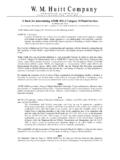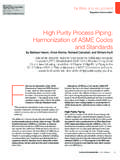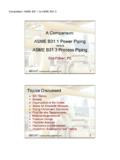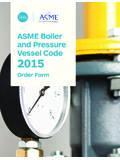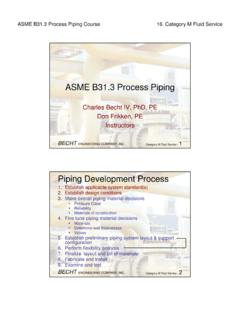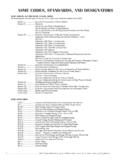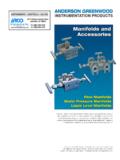Transcription of ASME B31.1 and ASME B31.3 General Requirements Overview
1 asme and asme General Requirements Overview Training Duration: 21 hours total (3 days x 7 hours). (Certi cate of Attendance will be provided). DESCRIPTION. A piping system is a set of pipes and other components (valves, elbows, etc.) used to transport uid from point A to B. asme (Power Piping) and asme (Process Piping), recognized by the Canadian Pressure Equipment Code CSA B51 (Boiler, Pressure Vessel, and Pressure Piping Code), contain all Requirements for industrial pressure piping. These codes are used in oil re neries and terminals as well as in various industries such as chemical, pharmaceutical, textile, pulp and paper, and cryogenics. asme is particularly associated with high-pressure steam boilers. These asme Codes establish the Requirements for materials, design, manufacturing, assembly, inspection, and certi cation of pressure piping pressure.
2 OBJECTIVES. This course o ers inspectors, engineers, and professionals working in the industrial pressure piping eld, an opportunity to understand all the main Requirements of asme and asme , 2014 edition. Upon completion of this course, the participants will be able to: Understand all the Requirements of asme and asme (relevant interpretations included). Perform an Overview on calculations to determine the minimum wall thickness of all piping system components according to associated external loads (pressure, hydrostatic test, and water hammer, etc.). TARGET ATTENDEES. Engineers Inspectors Technicians Contractors Professionals in the industrial pressure piping eld Page 1 of 3. asme and asme General Requirements Overview PROGRAM (3 Days). NOTE: The training is based primarily on asme Requirements in parallel with asme Requirements .
3 Day 1. 1. De nition of a pressure piping system (according to certain Canadian provinces). 2. The boundary between a reservoir and a pressure piping 3. Requirements ( Overview ) regarding piping in Canada, CRN, etc. (CSA B51, 2014 Edition). 4. The limits of codes ( asme and asme ). 5. How to nd information in the asme Codes 6. De nition of the di erent uid categories of asme (Normal, D, M, High Pressure, Elevated Temperature, Severe Cyclic, and High Purity) and the di erence between BEP (Boiler External Piping) and NBEP (Non-boiler External Piping) for asme 7. Description of the responsibilities of main parties and minimum quali cation Requirements for each of them 8. Standard vs. non-standard components 9. Material Requirements (including lower temperature limit calculations to verify if impact tests are required).
4 Day 2. 1. External constraints to be included in the piping design 2. De nition of pressure and temperature design 3. How to determine the pressure and temperature design based on operation data 4. Under what conditions can we authorise pressure/temperature upsets above design limits? 5. Requirements for protection against overpressure 6. Hoop stress formula to determine minimum required thickness of a pipe having an internal pressure 7. Type of pipe supports (MSS SP-58, MSS SP-69, and MSS SP-127). 8. Trunnion 9. Formula for piping bends (intrados and extrados). 10. Formula for miter bends 11. Branch connection opening calculations and examples Page 2 of 3. asme and asme General Requirements Overview Day 3. 1. Calculations of at covers (blank and blind anges). 2. Expansion joints 3. Overview of asme and asme Requirements 4.
5 Calculations of equivalent pressure (external axial force and moment) on standard ange 5. Manufacturing Requirements (welding, preheating, heat treatment, hardness test, etc.). 6. Weld defect tolerances 7. Leak test Requirements (hydrostatic, pneumatic, sensitive leak test, initial leak test, alternative leak test, etc.). 8. Additional Requirements on welds made without hydrostatic test (closure weld). Appendices (will be covered only if time permits): asme History Water hammer calculations Piping provided with internal refractory: equivalent elasticity modulus (E) calculations Pipes having an external pressure (vacuum) and examples It is highly recommended to bring a copy of asme and asme to better follow the training. asme Note 1: Chapter VII (paragraphs beginning with letters "A" and "MA") will not be covered in this training.
6 Note 2: The presentation is based on the Normal Fluid Service Requirements . Additional Requirements of category M uid service, high pressure uid service, elevated temperature uid service, and high purity uid service are included and will be compared to the Normal Fluid Service Requirements . asme Note 1: Chapter II, paragraph 122 (Design Requirements Pertaining to Speci c Piping Systems), Part 6. and Chapter VII (Operation and Maintenance) will not be covered in this training. Note 2: All appendices will not be included. Note 3: The training will focus on NBEP (Non-boiler External Piping) Requirements . Page 3 of 3.

